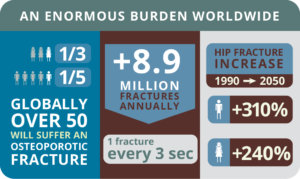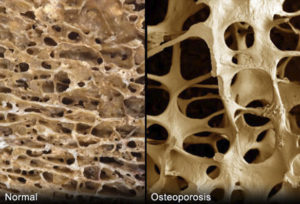What is Osteoporosis?

Osteoporosis is a condition in which bone density is decreased, leading to increased risk of fractures, especially after a fall or injury. About 54 million Americans have osteoporosis or low bone density. Data suggests that worldwide, approximately one in three women and one in five men over the age of 50 will suffer a fracture due to this disease. In the United States, these rates are even higher, with one in two women and one in four men sustaining and osteoporotic fracture in their lifetime. The most commonly broken bones due to osteoporosis are the hip, wrist, and spine. As a result of these fractures, patients are more likely to experience pain and reduced mobility. In order to prevent these complications, early recognition and treatment is extremely important.
Osteoporosis is known as a silent disease, because patients cannot feel their bones weakening. It is often diagnosed too late, after a fracture has already occurred. Some patients notice that they are losing height or developing a forward curvature of the neck and upper back, which may be early signs of osteoporosis. If you notice these signs, consult your doctor for evaluation.

The most common cause of osteoporosis is age-related changes in bone structure in formation. Women are at a significantly higher risk due to lack of estrogen following menopause. However, there are numerous known medical conditions and medications that may contribute to osteoporosis development. Some of these conditions include rheumatoid arthritis (RA), hyperthyroidism, certain cancers, and chronic kidney disease, among many more. Medications that may increase osteoporosis risk include oral steroids, chemotherapy drugs, and proton pump inhibitors (PPIs). At your visit, your healthcare provider will review your medical history to look for osteoporosis risk factors such as these.
Osteoporosis can be diagnosed with a bone mineral density (BMD) test, which measures how dense your bone is in certain regions. Your provider will order a scan that will calculate bone density. Additionally, you may have blood work done to see if other factors are leading to osteoporosis.
Osteoporosis Treatment & Prevention
Osteoporosis is treatable with both lifestyle  modifications and medications. Some important factors in the treatment of osteoporosis include getting regular exercise, adequate calcium intake, and avoiding smoking and alcohol. If your bone density is very low or you have had prior fractures, your provider may prescribe a medication to help increase or maintain your bone density. The goal of this therapy is to prevent future fractures and maximize bone density. Based on the results of bone density measurements, lab results, and calculated fall risk, your provider will create a treatment plan specific to you.
modifications and medications. Some important factors in the treatment of osteoporosis include getting regular exercise, adequate calcium intake, and avoiding smoking and alcohol. If your bone density is very low or you have had prior fractures, your provider may prescribe a medication to help increase or maintain your bone density. The goal of this therapy is to prevent future fractures and maximize bone density. Based on the results of bone density measurements, lab results, and calculated fall risk, your provider will create a treatment plan specific to you.
At Beach Orthopaedic Specialty Institute, we strive to keep our patients active and healthy. Preventing osteoporosis-related fractures contributes to patients’ quality of life and mobility. We believe that patients will lead happier, more active lives by addressing these bone health issues early on.

